To plant a tree that would “attract Kirtland’s Warblers” is the most interesting suggestion I’ve received, so far.
Having just posted the Catalpa post before heading off to facilitate three writing workshops Wednesday, I got some interesting suggestions from writers.
A Ginkgo?
Writer Mary R. enthusiastically suggested a Ginkgo.
Her suggestion for a Ginkgo came on the heels of me musing that I might plant the tree in a schoolyard or park instead of my own yard. So many aspects of a Ginkgo that might engage kids!
I already have a Ginkgo tree in my front yard, one that we had transplanted 5 or 6 years ago, moving it from beneath the Honey-Locust vs. Norway-Maple canopy competition, so it had more room to grow and wouldn’t end up with a bent trunk while trying to reach for the sun. It had been a Mother’s Day present for the last owner of our home, Noreen B. Now in the center of my front yard, in winter months it often sports white twinkly lights.

A favorite among several . . .
The Ginkgo, along with the Sycamore and the Beech, is one of 3 of my favorite trees in our yard.
Although I must say, my granddaughter Avery Grace‘s fascination with the swaying-in-the-breeze fruits of the Sweetgum tree, just over the border of our property to the west has been working on me the last three years since she first became aware of them on another Sweetgum when she lived in the Duke Forest.
Then there is my neighbor Suzanne C.’s magical quartet of front-yard trees: Hawthorn, Aspen, Birch, and Smoke Tree! She also has a large White Pine at the sidewalk, and on the west side and in the back, several Oaks, and a Walnut tree that drops its squirrel-favored fruit over our fence.
A White Pine?
Writer Harah F. suggested a White Pine.
This tree, formally known as an Eastern White Pine, was designated Michigan’s state tree in 1955.
The White Pine was chosen to serve in this role because from 1870 into the early 20th century Michigan led the nation in lumber production, and the White Pine was the most important of all “timber trees.”
Achieving this #1 lumbering status, of course, involved cutting down most of the state’s White Pines, many of which were “over 200 years old, two hundred feet in height and five feet in diameter.” Much of the forest land in Michigan “sold for as little as $1.25 an acre; and later, under the 1862 Homestead Act, men were hired to claim a plot of 160 acres and stay until the timber on it was cut.” [Emphasis mine; source: http://www.michigan-history.org/lumbering/LumberingBriefHistory.html]

But then, Harah F. reconsidered her suggestion, “But with climate change . . . ”
Certainly, a consideration. Currently, White Pines can be found in all of the state “except for the southwestern quarter of the Lower Peninsula.” [Source: Trees of Michigan: Field Guide by Stan Tekiela (Cambridge, MN: Adventure Publications, 2002, p. 27.]

However, I checked out the USDA Forest Service offering “A Climate Change Tree Atlas” for 134 species of trees. The map models forecasting the future of the White Pine in Michigan in a warming world show them decidedly less prevalent in Michigan.
A Buckeye?
Writer Susan H-B. suggested a Buckeye.
When I asked her why, Susan reminded me that she was from Ohio, sent me the buckeye photo below, and added, “I love buckeyes and somehow manage to collect one everywhere I go, even in France. The tree looks just like a tree you draw when you’re six, has the same rounded shape, just with buckeyes instead of apples.”

(Source: The University of Kentucky’s College of Agriculture, Food, and Environment’s Department of Horticulture’s website: http://www.uky.edu/hort/Ohio-Buckeye)
Known as the “Ohio Buckeye,” this tree is the state tree of Ohio as well as the name of Ohio State University football team. Oh, dear! While the Klotzbach side of my family came, most recently, from Cleveland, Ohio, our youngest daughter, Caitlin Skye, graduated from the University of Michigan. So, given the Wolverine vs. Buckeye rivalry, perhaps not.
Despite being officially known as the Ohio Buckeye, (as well as the American Horse-Chestnut), the Buckeye is native to Michigan, growing in the southern part of the Lower Peninsula. Although we probably should be expecting the Buckeye’s range to be moving north in the warmer years to come.
Reading up on the Buckeye–if I’ve ever seen one, I didn’t know that was what I was looking at–I discovered a few more reasons why a Buckeye might not be the best choice :
- The Buckeye’s green flowers–and most other parts of the tree–emit a foul odor when crushed (the tree is also known as “Fetid Buckeye” or “Stinking Buckeye”)
- The Buckeye’s fruit is a 1-2″ spiny capsule, which could add to the challenge of walking barefoot in my front yard between the Sycamore and Sweetgum (although no sprained ankles have yet occurred from the fruits of either in our time here)
- The Buckeye’s seeds are poisonous and avoided by wildlife.
[Source of information in the list above: Trees of Michigan: Field Guide by Stan Tekiela (Cambridge, MN: Adventure Publications, 2002, p. 211.]
A second vote for a Catalpa
Writer Rhonda H. had not yet read my most recent blog posting when she recommended a Catalpa tree, not knowing it had also been suggested by Jan P.
When Rhonda is not writing, she’s delivering mail in Birmingham, MI. She identified a Cedar St. in Birmingham as a street where Catalpas have been planted. (Interesting note for local readers: Cedar St. runs south into a two-block Catalpa Drive, a different Catalpa Drive from the one known as “11-and-1/2 Mile” that runs through Royal Oak and Berkley.)
Later, after she’d read my Catalpa post, Rhonda H. e-mailed me, writing, “I was reminded of a Catalpa I love on one of my routes. It’s [on] Oakland Ave. . . . What I especially love about it is the way the light filters through the leaves . . . I don’t know why this particular Catalpa captivates me. Cedar’s catalpas are much older and grander. This one’s youngish, but pretty much takes up the whole front yard. I wish you could see it with leaves, in sunlight.”
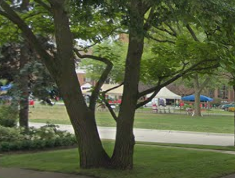
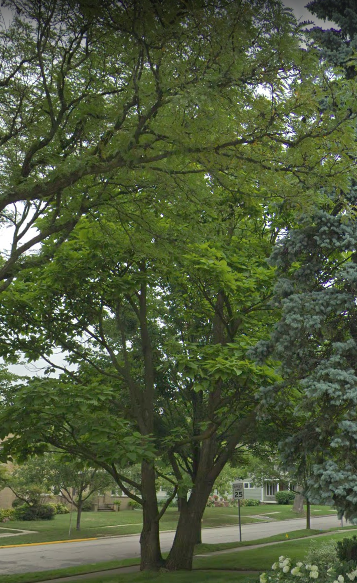
Above: Rhonda H.’s favorite Catalpa (L) with what seems to be a double trunk in the (unfortunately fuzzy) screenshot of Google Maps’ address photo; notice zig-zagging branches and (R) behind what appears be a Honey Locust on the right and a Blue Spruce on the left, growing on Oakland Ave. in Birmingham, MI (source: Google Maps Street View, August 2018)
The Nextdoor Catalpa Gang
I recently started following the Gardening & Landscape (G&L) interest group on Nextdoor, the private social network for communities. Yesterday, after having received the two Catalpa tree votes, I headed a post in the G&L group entitled “Catalpa tree, anyone?”
Nextdoor G& L members,–Elyse C., Lisa H., Rebecca B., Chuck H., Michelle L., and Laura C.–all responded positively to my inquiry about the choice of a Catalpa. In addition to this group’s apparent unanimous love of the tree, Chuck sent a photo of his flourishing Catalpa. Both Elyse and Laura offered me one of their baby Catalpa saplings (apparently, like Maples, Catalpas plant themselves). Michelle provided a description of the Catalpa flowers, ending with a two-word sentence: “A joy.”
Members of the Catalpa Gang gave me specific locations of where I could find Catalpa trees growing locally. Saturday, on a brisk two-mile walk to downtown Royal Oak, I came across these three:



Now about those Kirtland’s Warblers . . .
Writer Tim H. was the person who suggested I plant a tree that would attract Kirtland’s Warblers.
This meant a little bit of bird research. I read that while the Kirtland’s Warbler was nearly extinct 50 years ago, its population is increasing. I know from the reports of birders that Kirtland’s Warblers, during migration season, have been seen on Pelee Island, an Ontario island in the western basin of Lake Erie, where we have a cottage. But where is home for the Kirtland’s Warbler?
“[Kirtland’s Warbler] is noted for its extremely limited range [breeding only in north-central Michigan]. During the breeding season, it is confined to dense stands of young jack pines that spring up after forest fires in. Once such stands reach about 20 feet, the birds abandon them. Even in winter [in the Bahamas] it inhabits low scrub, although not always pines. Recently a sanctuary has been established by the State of Michigan where controlled burning will attempt to maintain the required habitat of this rare bird.
The Audubon Society Field Guide to North American Birds: Eastern Region by John Bull and John Farrand, Jr. (New York: Alfred A. Knopf, 1977)

A Jack Pine?
No wonder the Kirtland’s Warbler is also known as the Jack Pine Warbler.

I suspect Tim H. will be disappointed, but although I love Jack Pines and wouldn’t mind sharing my yard with one, I’m never going to be able to provide a “dense stand of young jack pines” here in Royal Oak, not in my lifetime, let alone engage in controlled burns. It also appears we’re too far south and east for the Kirtland Warbler’s to appreciate a dense stand of young jack pines even if I could provide them one.
A Birch?
Our neighbors Lynn L. and Fred G. treated us to dinner Saturday evening, and they both rooted for a Birch. They have long had a love affair with the one in the yard behind theirs.

There are other birches in the neighborhood, including right next door, although they have always seemed happier to me Up North . . .

Current finalists
These are the six trees I’ve received recommendations to plant so far:
- Catalpa (2)
- Gingko
- Eastern White Pine
- Ohio Buckeye
- Jack Pine
- Paper Birch
Romeo weighs in
Last night at my first “island book” presentation of 2019, a woman who had been in the audience approached me while I was signing books and whispered in my ear, “Gingko biloba.” It took me a minute. During the period at the end of my talk where I take questions, someone had asked what I was working on now. So, I told them about the Arbor Day Plot. Then I had returned to islands.
This woman was suggesting I plant a Gingko, using the tree’s Latin name: Gingko biloba. She explained Gingkos are the oldest trees on earth and have beautiful fan-shaped leaves.
So, the week began with a second vote for Gingko.
[Gingko] trees . . . grew up with the dinosaurs and have come down to us almost unchanges for 200 million years . . . Gingko is now the most widely recognized of all botanical “living fossils” . . . Fossil gingko leaves are known from every continent. The prehistory of ginkgo goes back to before the Atlantic Ocean existed and before the southern continents broke from Antarctica and went their own ways . . . Human dominance on our planet could have meant the end for ginkgo, but unlike many other trees, it has flourished alongside people. In one way or another, it has proved useful; more unusually, it has become revered.
— Peter Crane in Ginkgo: the tree that time forgot (London: Yale University Press, 2013)
The time is nigh
If you have any opinions–pro or con–about any of these six trees, or another tree to recommend, please get it/them to me this week. I’m feeling with this morning’s sun and the temperature on the rise, next week would be a good time to make a decision. The questions of where and how and who’s going to plant loom.


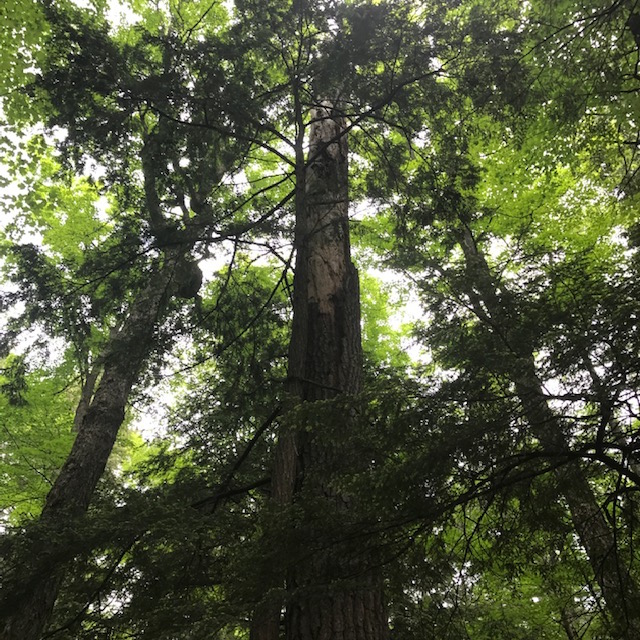

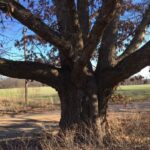
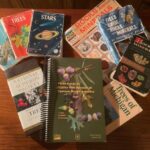
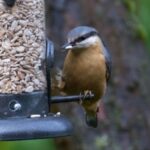
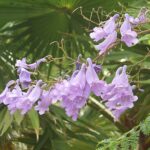
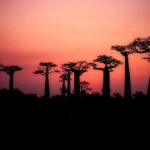
Have you considered a pawpaw? They are native to Michigan. They have large (think apple) fruit. The fruit tastes like banana and custard.
Thank you for your suggestion, Al! I know absolutely nothing about Pawpaws, but just now checking them out in my tree book, see that they are also called: “Pawpaw-apple” and “False-banana,” so your comments make sense. Have you known a Pawpaw personally? I’m thinking you must have if you’ve tasted their fruit.
I vote for the Ginkgo and maybe planting it near a senior center!
What a great idea, Eileen! Especially given the relationship of longevity and memory to the Ginkgo. And, our connection to one particular senior center.
Were you reading in Romeo?? My husband grew up there and we raised our kids there for twenty years. Warblers are really picky as you noted. Jack pines only live to 75 years, so I don’t think I’d do that one. When they get old, they get really unsightly, too. Think Blair Witch Project. We had to clear our 35 acres in the U.P. of them since they were at the end of their lifespan. We DID scarify the earth with their tops so they’d grow back, but that makes more sense there–we wouldn’t have to actually plant them then. They are growing back already. So I guess my votes are just “against” type votes. We do love our white and red pines on the property, though. White pines live a very long time and can be really impressive. And it’s always nice to have winter foliage.
I was presenting my island slide presentation and reading from my book in Romeo last night, Lynn, at the Romeo Monday Club that raises money for college scholarships for Romeo students. What a nice group of smart and engaging women! And, what a pretty town! I had a beautiful sunny day for the drive. Had no idea it was home to you at one time. I thought the only way Jack pines grew back was by fire bursting their seeds, but apparently not. I had to look up “scarify,” and I’m still not sure how it works. It would be nice to have some green in the winter. I know less about evergreens than I do about deciduous. As you can see in the photo of my neighbor’s white pine, it’s had to reach for light from under the rest of the canopy. And, they do grow big! Saw a lot on my way to Romeo yesterday.